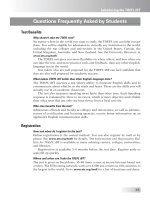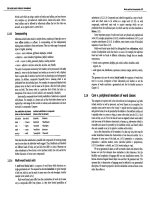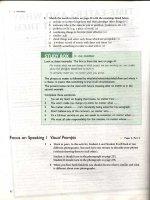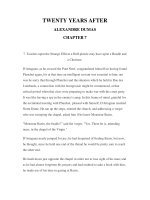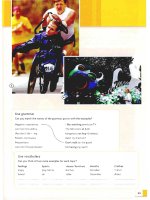Reading comprehention 7 ppsx
Bạn đang xem bản rút gọn của tài liệu. Xem và tải ngay bản đầy đủ của tài liệu tại đây (78.08 KB, 6 trang )
Answer Key
If you miss any of the answers, you can find help for that kind of question in the lesson(s) shown to the right of
the answer.
– PRETEST–
16
1. c. Lesson 1
2. a. Lesson 1
3. d. Lesson 9
4. a. Lesson 16
5. b. Lesson 3
6. c. Lesson 12
7. c. Lesson 2
8. b. Lessons 6 and 7
9. a. Lesson 3
10. b. Lesson 8
11. d. Lesson 4
12. c. Lesson 17
13. d. Lesson 2
14. b. Lesson 8
15. c. Lesson 4
16. b. Lesson 13
17. a. Lesson 19
18. d. Lesson 3
19. c. Lesson 8
20. c. Lesson 19
21. b. Lesson 19
22. a. Lesson 16
23. c. Lesson 13
24. a. Lesson 14
25. b. Lesson 11
26. d. Lesson 9
27. c. Lesson 1
28. a. Lessons 6 and 10
29. d. Lesson 3
30. d. Lesson 6
31. b. Lesson 18
32. c. Lesson 2
33. c. Lesson 12
34. a.
Lesson 12
35. b. Lesson 13
36. a. Lesson 11
37. c. Lesson 2
38. c. Lesson 4
39. d. Lesson 3
40. c. Lessons 6, 7, and 10
41. d. Lesson 8
42. a. Lesson 9
43. b. Lesson 11
44. b. Lesson 12
45. c. Lesson 3
46. a. Lesson 14
47. d. Lesson 18
48. b. Lesson 16
49. d. Lesson 17
50. a. Lesson 17
17
Building a
Strong
Foundation
Y
ou may not have thought of it this way before, but critical readers are a lot like
crime scene investigators. In their search for the truth, they do not let opin-
ions sway them; they want to know what actually happened. They collect tan-
gible evidence and facts and use this information to draw an informed conclusion.
Separating fact from opinion is essential during a crime scene investigation. It is also a cru-
cial skill for effective reading.
When you read, look for clues to understand the author’s meaning. What is this pas-
sage about? What is this writer saying? What is his or her message? At times, it may seem
like authors are trying to hide their meaning from you. But no matter how complex a piece
of writing may be, the author always leaves plenty of clues for the careful reader to find. It
is your job to find those clues. Be a good detective when you read. Open your eyes and ask
the right questions. In other words, read carefully and actively.
The five lessons that follow cover the basics of reading comprehension. By the end
of this section, you should be able to:
■
Find the basic facts in a passage
■
Determine the main idea of a passage
■
Determine the meaning of unfamiliar words from context
■
Distinguish between fact and opinion
magine, for a moment, that you are a detective. You have just been called to the scene of a crime; a house
has been robbed. What’s the first thing you should do when you arrive?
a. See what’s on the TV.
b. Check what’s in the fridge.
c. Get the basic facts of the case.
The answer, of course, is c, get the basic facts of the case: the who, what, when, where, how, and why. What
happened? To whom? When? Where? How did it happen? And why?
As a reader faced with a text, you go through a similar process. The first thing you should do is establish the
facts. What does this piece of writing tell you? What happens? To whom? When, where, how, and why? If you can
answer these basic questions, you’re on your way to really comprehending what you read. (You’ll work on
answering the more difficult question—“Why did it happen?”—in Lesson 2.)
LESSON
Getting the
Essential
Information
LESSON SUMMARY
The first step in increasing your reading comprehension is to learn how
to get the basic information. Like a good detective, start with the basic
facts. To get the facts, be an active reader and look for clues as you
read.
1
19
What Are the Facts?
Let’s start with a definition. A fact is:
■
Something that we know for certain to have
happened
■
Something that we know for certain to be true
■
Something that we know for certain to exist
Much of what you read, especially today in this
“Information Age,” is designed to provide you with
facts. You may read, for example, about a new office
procedure that you must follow; about how the new
computer system works; about what happened at the
staff meeting. If you’re taking a standardized test, you’ll
probably have to answer reading comprehension ques-
tions that ask about the facts in a reading passage.
These facts are not always easy to determine, especially
if the writing is dense or complicated. To make it sim-
pler, ask yourself these questions as you read: What
facts am I expected to know? What am I to learn or be
aware of? What happened? What is true? What exists?
Practice Passage 1
Jump right into the task of finding facts. The following
brief passage is similar to something you might see in
a newspaper. Read the passage carefully, and then
answer the questions that follow. Remember, careful
reading is active reading (see the Introduction), so
mark up the text as you go. Underline key words and
ideas; circle and define any unfamiliar words or phrases;
and record your reactions and questions in the margins.
– GETTING THE ESSENTIAL INFORMATION–
20
On Friday, October 21, at approximately 8:30 a.m., Judith Reynolds, owner of
The Cupcake Factory, arrived at her establishment to find that it had been
robbed and vandalized overnight. The front window of the shop at 128 Broad
Street was broken, and chairs and tables were overturned throughout the café
area. Additionally, the cash register had been pried open and emptied of money.
The thieves attempted to open the safe as well, but were unsuccessful. Ms.
Reynolds used her cell phone to report the crime to the police. She also phoned
the proprietor of Primo Pizza, located at 130 Broad Street, as she noticed that the
door of that restaurant showed signs of forced entry. The police department is
asking anyone with information to call 555-2323.
1. What happened to The Cupcake Factory?
2. When was the crime discovered?
3. Where did it happen?
4. What was stolen?
5. Who called the police?
6. What other businesses were affected?
Remember, good reading is active reading. Did you mark up the passage? If so, it may have looked something
like this:
– GETTING THE ESSENTIAL INFORMATION–
21
On Friday, October 21, at approximately 8:30 a.m.,Judith Reynolds, owner of
The C
upcake Factor
y, arrived at her establishment to find that it had been
r
o
bbed and vandalized overnight. The front window of the shop at 128 B
roa
d
Str
eet was broken, and c
hairs and tables were o
ver
turned throughout the café
area
. Additionally, the cash r
egister had be
en pr
ied open and emptie
d of money
.
T
he thie
ves attempted to o
pen the safe as well, b
ut we
re unsuccessful. Ms.
Reynolds used her cell phone to report the crime to the police. She also phoned
the p
roprietor o
f Primo Pizza, located at 130 B
roa
d Street, as she noticed that the
door of that restaurant showed signs of forced entry. The police department is
asking anyone with information to call 555-2323.
You’ll notice that the answers to the questions
have all been underlined, because these are the key
words and ideas in this passage. But here are the
answers in a more conventional form.
1. What happened to The Cupcake Factory? It was
robbed and vandalized.
2. When was the crime discovered? At 8:30
A.M
.on
Friday, October 21.
3. Where did it happen? 128 Broad Street.
4. What was stolen? Money from the cash register.
5. Who called the police? Judith Reynolds, owner of
The Cupcake Factory.
6. What other businesses were affected? Possibly
Primo Pizza.
Notice that these questions went beyond the basic
who, what, when, and where to include some of the
details, like why the proprietor of the restaurant next
door was called. This is because details in reading com-
prehension, as well as in detective work, can be very
important clues that may help answer the remaining
questions: Who did it, how, and why?
when who
another
business
was affected
what happened—
robbery and
vandalization
unclear if anything was
taken from Primo Pizza
from this report
what a
mess!
money was
stolen
interesting
detail
where

